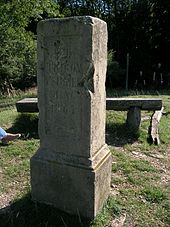Surveying pillar



A surveying pillar or measuring pillar is the most stable marker for a survey point. It can be made of concrete or masonry; Occasionally, locally available rock is also used (in the picture: hard sandstone ).
Such pillars are about four feet high with a cross section of at least 35 cm × 35 cm - depending on the size of the largest measuring instrument used . They are mainly built for measuring points where repeated observations are required - e.g. B. for deformation and control measurements on dams or other large technical projects.
The erection of pillars at trigonometric points (TP) is also useful in national surveying , if special observations are planned there, such as precise plumbing deviations with large astrolabes or astro-geodetic azimuths for comprehensive network control ( Laplace points ).
A stable pillar must be at least 80 cm deep sound are or built directly on bedrock, as the frost depth is cm in many winters 60th A stainless steel or brass plate is embedded in the top of the square cross-section , on the center of which the measuring instrument ( universal instrument , triangulation theodolite , electronic spacer, etc.) is precisely placed or screwed. Pillars for astronomical and Laplace points generally have a cross-section over 40 cm in order to be able to set up a passage instrument or a Danjon astrolabe . For particularly critical measurements - e.g. B. on the portal points of a tunnel - a separate wooden pedestal must be erected for the geodesist in order to prevent the slightest pillar rotation and inclination that would result from the movements of the observer.
Particularly massive and thermally stable pillars are necessary for large instruments in observatories . Their foundation extends not only to the frost line in the ground, but many meters deeper. Concrete is thermally unfavorable, but a tried and tested design is the ventilated brick construction .